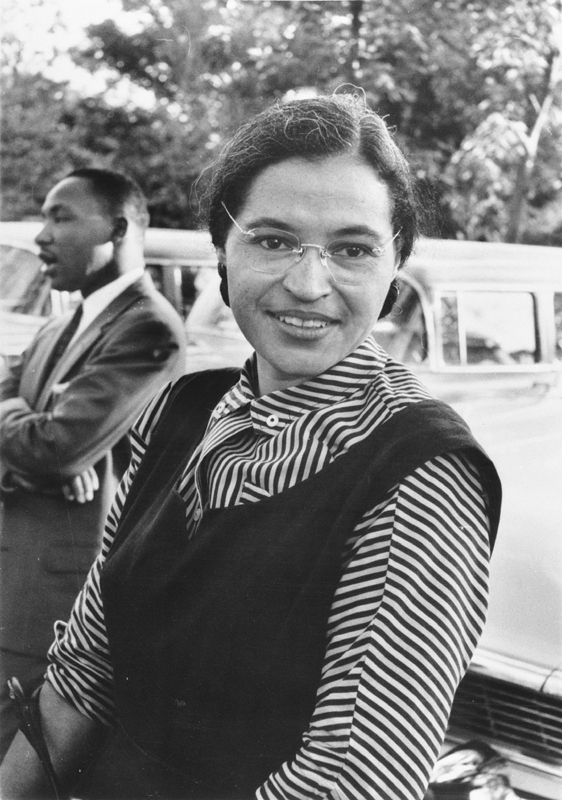Winner of the Fall 2016 StMU History Media Award for
Best Article in the Category of “People”
When one hears the name Rosa Parks, one is taken back in time to 1955, when a brave woman decided not to give up her seat. Rosa Parks was a woman who believed that the color of a person’s skin should not dictate the way a person is treated. Rosa Parks was a civil rights activist.

James McCauley, a skilled carpenter and stonemason, and Leona McCauley, a school teacher, were married on April 12, 1912, in Tuskegee, Alabama. Two months before their first anniversary, on February 4, 1913, in Tuskegee, Alabama they welcomed a daughter into their lives and named her Rosa Louise McCauley. On August 20, 1925 the McCauleys welcomed their son, Sylvester McCauley, into their family.1 The McCauley family decided to move to Abbeville, Alabama where they lived with James’s parents, sharing a bedroom with a large extended family. Rosa’s mother grew tired of the living arrangements and without her husband James around to support the family, she made the decision to leave. In 1917, when Rosa was only 4 years old, Leona took her two young children and moved back to Pine Level, Alabama where she and the children stayed with her parents. Rosa saw her father a year later when she was five and then again when she was an adult and married.2
Rosa received most of her education from her mother and grandfather as a little girl. In 1924, when Rosa was eleven years old, her mother enrolled her in the Montgomery Industrial School for Girls. The school was for African American girls seeking education; they were taught by mostly white teachers. The school focused on the domestic sciences of cooking, sewing, and housekeeping. The white people of the town accused the teachers of teaching racial equality and referred to them as Yankee black lovers. The school was later burned down by the Ku Klux Klan as they grew more powerful.3 After the Montgomery Industrial School for Girls closed in 1928, fifteen year old Rosa attended Booker T. Washington High School for her ninth grade year. She wanted to be a teacher just like her mother, so for her tenth grade year Rosa attended Alabama State Teachers College for Negros. Sadly, she had to drop out of school and return to Pine Level, Alabama to care for her grandmother who had grown ill. When her grandmother died in 1929, Rosa was only 16 years old. She moved back to Montgomery and found her first job making men’s blue denim work shirts at a textile factory. Soon after beginning her job in the factory, Rosa was forced to leave in order to care for her mother who had also grown ill.4 Rosa spent her teenage years cleaning houses and taking in sewing jobs. In 1931, Rosa met Raymond Parks, who worked as a barber and was a member of the National Association for the Advancement of Colored People (NAACP).5 The two fell in love and in December 1932, Rosa and Raymond were married. Raymond encouraged his new bride to go back to school so as to finish her education. This meant so much to her, and so Rosa completed her studies and received her high school diploma in 1934.6

By 1943 all buses in the South had long been segregated and had followed an extensive set of rules set forth by the bus drivers. Montgomery, Alabama was no exception to the segregation. All the buses had thirty-six seats; the first ten were reserved for whites only, ten seats in the back of the bus were for African Americans, and as for the sixteen seats in-between, these were for the bus drivers to decide. African Americans were frequently forced to give up their seats for whites and the bus drivers imposed their own segregation rules through the use of guns they carried with them.7
In November of 1943 Rosa boarded a bus in Montgomery, Alabama. African Americans were typically required to enter the bus from the doors located near the back of the bus, but since the bus was extremely crowded, Rosa was forced to enter from the front doors of the bus. The bus driver demanded she get off the bus and enter through the back door and Rosa refused, standing her ground and explaining to the bus driver that since she was already on the bus there was no need for her to get off because the back of the bus was already at capacity and she would not be able to enter from the back. The bus driver began tugging at Rosa’s coat to push her off the bus and so she decided to not create more of a scene and exited the bus.8
On December 1, 1955, Rosa headed to work at the Montgomery Fair Department Store on the Cleveland Avenue bus to Court Square. It was a normal day for Rosa, working her regular shift, busy as usual.9 Once work was over, Rosa was tired; her body ached, her feet hurt and were swollen from standing all day. Rosa walked to Court Square to wait for her bus and as soon as the first bus came, she saw that it was packed and decided to wait for the next one. Once the second bus arrived Rosa entered the bus, paid, and sat in the racially neutral middle section behind the movable sign which read “colored.”10 At the third stop, a group of whites entered the bus and since the last front seats were taken, one was left standing. The bus driver turned around and looked at Rosa. Rosa was shocked to see that it was the same bus driver she had had a problem with twelve years earlier. The driver, James F. Blake, began to shout at the passengers, “Move ya’ll, I want those two seats,” meaning he wanted Rosa to give up her seat. Rosa did not get up and Blake went straight to Rosa demanding she give her seat up. When Rosa still would not comply he warned her that he would have her arrested, to which she simply replied, “You may do that.”11
Once police arrived, Rosa was arrested, handcuffed and taken to the police station. At the station, Rosa was finger printed, photographed and placed in a cell. While in jail Rosa was treated badly. She requested a drink of water and a police officer yelled out to her “for whites only.” She even requested to make one phone call and was ignored. After requesting several times to make her phone call, she was finally given approval and she phoned her husband. Edgar Daniel Nixon, an African-American civil rights leader, paid a one-hundred dollar bond to bail Rosa out of jail. Rosa worked with Nixon as a branch secretary. In speaking with Nixon about the incident, Rosa decided to file suit and make a civil rights case regarding Montgomery’s bus segregation.12 On the day of trial, December 5, 1955, African Americans in Montgomery boycotted the buses and Rosa was found guilty of breaking segregation laws.13 The boycott proved to be a large protest, and it led to the formation of the Montgomery Improvement Association (MIA).14 On November 13, 1956, the Supreme Court ruled that bus segregation was unconstitutional and the boycott ended on December 20, 1956.15 Rosa became known as the mother of the Civil Rights Movement.16

Rosa Parks traveled and supported civil rights events and causes and even wrote an autobiography, “Rosa Parks: My Story.” In 1999, for all her accomplishments and beliefs as a strong African American, Rosa was awarded the Congressional Gold Medal, which is the highest honor in the United States presented to a civilian.17 On October 24, 2005, at the age of 92, Rosa Parks passed away. She became the first woman in the nation’s history to lie in state at the U.S. Capitol.18
Rosa Parks left a major impact on America and made history. She stood up for what was right for herself and for the people, not because of the color of their skin but because she believed that everyone should be treated equally. She boarded a bus at the end of a long work day, tired and wanting to go home, not realizing that she would forever change segregation in America. Rosa Parks was a very noble woman and she left behind a legacy that will never be forgotten.
- Salem Press Biographical Encyclopedia, January 2016, s.v. “Rosa Parks,” by Tammy K. Baggett. ↵
- Douglas Brinkley, Rosa Parks (Penguin Group Penguin Putnam Inc., 2000), 20-21. ↵
- Brinkley, Rosa Parks, 28, 29, 36. ↵
- Brinkley, Rosa Parks, 36. ↵
- Brinkley, Rosa Parks, 38. ↵
- Salem Press Biographical Encyclopedia, January 2016, s.v. “Rosa Parks,” by Tammy K. Baggett. ↵
- Brinkley, Rosa Parks, 57. ↵
- Brinkley, Rosa Parks, 58-59. ↵
- Salem Press Biographical Encyclopedia, January 2016, s.v. “Rosa Parks,” by Tammy K. Baggett. ↵
- Brinkley, Rosa Parks, 105. ↵
- Brinkley, Rosa Parks, 106-107. ↵
- Brinkley, Rosa Parks, 73, 108, 109, 111, 113, 114. ↵
- Brinkley, Rosa Parks, 152. ↵
- Brinkley, Rosa Parks, 134. ↵
- Brinkley, Rosa Parks, 152, 170. ↵
- Rosa Parks: “The First Lady of Civil Rights,” Bill of Rights Institute, March 2, 2012, http://billofrightsinstitute.org/rosaparks/. (accessed November 7, 2016). ↵
- Salem Press Biographical Encyclopedia, January 2016, s.v. “Rosa Parks,” by Tammy K. Baggett. ↵
- Salem Press Biographical Encyclopedia, January 2016, s.v. “Rosa Parks,” by Tammy K. Baggett. ↵




79 comments
Anayeli Prieto
Great article. it is very important that we as people solve the issues in our society and fight for what we believe in. she was a huge inspiration to all of African Americans to fight for the rights that they earned when slavery was abolished. she toughed through being treated harshly in the jai cell and she was a major contribution to our lives today.
Luke Trevino
Wow!! This article was great! I knew of what Rosa Parks had done on the bus but never what she did after! I never knew she started a boycott to busses or that she was awarded the highest civilian award possible. She is truly and American hero saving us from ourselves! This was truly an amazing article will most defiantly recommend to a friend!
Nahim Rancharan
This was an excellent article on Rosa Park! It was interesting to see how one person, no matter race, gender or ethnicity was able to stand up for what she believed in despite having the odds against her. It is true that actions speak louder than words, and Rosa Parks stayed true to this idea given that she refused to give up her seat on the bus. In society, few people have the courage to stand up for what they believe in, but the few that do have the power to affect change and that makes all the difference. Her actions, no matter how small they were, gave way to more advancements in regards to Civil Rights such as the implementation of the NAACP and the MIA. Rosa Parks is a hero in American History and her actions will forever hold a place when looking back at the Civil Rights Movement in America. Great Article!
Elizabeth Garibay
Growing up hearing this story she became a person I admired. I deeply enjoyed reading about Rosa Parks background as I always had just learned straight forward facts about her story.It was great learning more about her and seeing her as even more than a woman who did not give up her seat. It is a shame that by not giving up her seat to a white bus rider she was thrown in jail like a criminal with no rights. Not only being African American she is also a woman and this inspired me as a child. She stood up to people who were seen as superior and she showed no fear no matter what. This was an inspiring article!
Johnanthony Hernandez
Amazing article, well written a great background information that I did not know. It’s amazing to see someone stick to their beliefs despite the growing racial tension at the time. Especially having two aggressive encounters with the same person. It is great to see that toward the end of her life that she was recognized for her actions in the Civil Rights Movement.
Marissa Gonzalez
Great job on providing much detail in this article! The background information on Rosa Parks was something I was not familiar with. Even though she is popular for not giving up her seat to a white man, it is nice to know where she came from and how she was raised. I did not realize that she was awarded with the Congressional Gold Medal which is very impressive. It’s amazing how a single woman was able to make a change in segregation laws because she was not afraid to defend what was right.
Tyler Sleeter
I did not know much about Rosa Parks before reading this excellent article. This article is written in chronological order with so much background information on Rosa Parks that it is easy to see how she came to be considered such a great public figure. I especially liked the last paragraph where the author points out that Rosa Parks was just a tired working woman on the way home from a long day at work who just wanted to stay in her seat. This tired woman became an inspiration for all people seeking to improve the quality of life in our communities.
Aaron Mcglown
Great article, Aurora! I love the background information you gave on Rosa Parks. Being an African American I believe in everything she stood up for. She is the best example of how simple things can turn into a great impact on the world. We are facing the same conflicts today towards African Americans today. Maybe one individual can do what Parks did so many years ago.
Lianna Ybarra
I truly enjoyed this piece! I didn’t know much of the background information of Rosa Parks and I thought it was great and noble how she always wanted to go to school and be a teacher. It is terrible to think how the bus drivers could threat the African American’s with a gun to move to the back or be physical with them. I find it intriguing how her one simple no to get off the bus changed so many things for the future. It brought the attention to many, such as the court systems. If she hadn’t said no, would we still be living in that hatefulness?
Nataly Solis Chavez
What an inspiring article and very well written! It always amazes me how only one voice can be the turning point to make a difference. It was interesting to read about Rosa Parks earlier years, it gives valuable information as to who she was. You can definitely tell you took the time do do the research necessary to cover this important figure in history and you wrapped it all together very well.